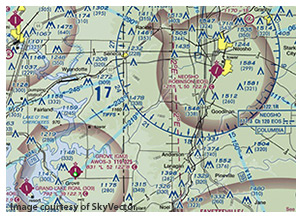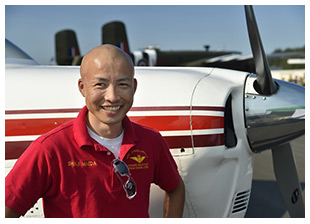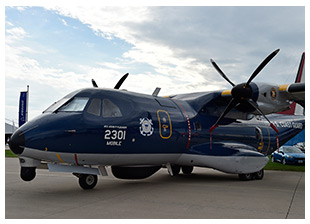Training Tips
|

Sponsored by Aircraft Spruce
It's misting with a 300-foot overcast ceiling when you arrive at the airport. With low clouds and zero wind, it's anybody's guess when the weather may improve, as it was advertised to do later in the morning. To pass the time, your flight instructor quizzes you about the planned cross-country flight and destination airport. Read more...
 
|
|
Flight Training News
|

Article
A motor vehicle crash that robbed Japanese-born Shinji Maeda of half his eyesight at age 18 nearly extinguished his dream of becoming a professional pilot. Now 37, Maeda was emotional about the accident as he recalled how he overcame the physical and mental trauma of a crushed optic nerve to become a commercial pilot and inspirational speaker. Read more...
 
Article
James Koonce remembers the day in October 1966 when a student pilot celebrating his seventeenth birthday showed up at his Joplin, Missouri, fixed-base operation in a Cessna 150 for a private pilot checkride. Read more...
 
Pan Am inks deal with Cessna
Pan Am International Flight Academy in Miami announced Aug. 31 that it signed a multi-year deal with Cessna Aircraft Co. to purchase aircraft including the Skyhawk exclusively from Cessna for primary flight training. Pan Am's international and career flight academies trace their roots to Pan American World Airways' ocean-crossing routes and Clipper flying boats popularized in the 1930s.
Bonanza Society offers paid internship
Collegiate and post-collegiate students who are seeking a professional aviation career path may apply for the American Bonanza Society's paid internship program based at the society's Wichita, Kansas, headquarters. The program, which runs from January through June 2017, provides "young aviation professionals unparalleled introduction and access to industry leaders, regulators and policy makers." The application deadline is Oct. 1. Visit the American Bonanza Society website for more information.
Video
Here's a reminder to always handle a propeller as though it will turn over unexpectedly, because it just might—like it did to Bruce Stanfield. In Real Pilot Story: Propping Accident, Stanfield explains what happened when a hot magneto and pilot complacency converged at the wrong time. Watch the video...
 
|
Scholarships
|
Whirly-Girls scholarship deadline approaches
The Whirly-Girls, International Women Helicopter Pilots is offering three new scholarships: the Garmin GTN and G500/600 Course scholarship, the Night Flight Concepts Night Vision Goggle Initial Pilot Qualification scholarship, and the Robinson Helicopter R66 Safety Course scholarship. The group also offers 10 additional scholarships. Applications cost $50 and are due Oct. 1. For more information and to download the scholarship applications, visit the Whirly-Girls website.
|
AOPA Live
|
|
AOPA Live This Week
Outdated fixed-timing magnetos should be a thing of the past, and AOPA Editor at Large Dave Hirschman shows how electronic ignitions can cut fuel burn, improve reliability, and reduce costs. Also this week, tour Duncan Aviation's maintenance, repair, and overhaul facility in Battle Creek, Michigan, the location of AOPA's Fly-In Sept. 16 and 17. And, find out how one-G Simulation is using simulators to enhance flight training. Watch AOPA Live This Week®, Sept. 8...
 
|
|
Plane Spotter
|

Ocean Sentry
With a large rear ramp built into its striking fuselage, the Ocean Sentry HC-144A, built by Airbus, can be adapted to various missions, and is particularly prized by the U.S. Coast Guard for its endurance of more than 10 hours and its capability for "locating objects in large search areas, and vectoring other military, government and first responders to these locations." The high-winged twin turboprop can be spotted cruising above the water or on display at an aviation gathering.
|
Training Products and Resources
|
|
Video
That's precisely what you'd be doing by entering instrument meteorological conditions when flying VFR. You'll get the idea watching the AOPA Air Safety Institute's Flying Blind Pilot Safety Announcement. Watch the video...
 
Inflatable water safety device fits on your wrist
A handy wrist-worn water safety device can help in an emergency or provide peace of mind while participating in active water sports. The Kingii emergency floatation device straps to your wrist like a watch, and a CO2 cartridge fills an inflatable orange bag that provides 13 pounds of buoyancy that "can help pull you to the surface, or keep you afloat until help arrives." The wristband includes a compass and a safety whistle. The reusable device is available from Sporty's Pilot Shop for $79.99.
|
|
Note: Products listed have not been evaluated by ePilot editors unless otherwise noted. AOPA assumes no responsibility for products or services listed or for claims or actions by manufacturers or vendors.
|
Member Benefits
|
|
Pilot Protection Services
The FAA and air traffic control want pilots to ensure that their aircraft transponder is on and in the altitude reporting mode while operating on movement areas at all airports. Read more...
 
|
Blogs
|
|
Opinion Leaders blogger Ron Rapp notes that the air carrier pilot shortage has affected career pilots because competent flight instructors are quickly snapped up by the airlines. He explains that some of the best instruction occurs unofficially in the cockpit because every co-pilot is a captain in training. Read more...
 
|
Final Exam
|
Question
Can you tell me what the number on the approach end of a runway indicates? For example, my airport has the number 9 on one end and 27 on the other.
Answer
The runway number is determined by its magnetic orientation. The Aeronautical Information Manual states:
"Runway numbers and letters are determined from the approach direction. The runway number is the whole number nearest one-tenth the magnetic azimuth of the centerline of the runway, measured clockwise from the magnetic north. The letters, differentiate between left (L), right (R), or center (C), parallel runways, as applicable:
1. For two parallel runways 'L' 'R.'
2. For three parallel runways 'L' 'C' 'R.'"
Add a zero to the end of the runway number and you will know what magnetic direction you are heading when taking off or landing. For example, if you are landing on Runway 9 at your home airport, you would be heading east, or 90 degrees on the compass. Runway 27 has a magnetic heading of approximately 270 degrees, or roughly west. For more information on how runways are laid out, read this AOPA Online article.
|
|
Did you know that student pilots who join AOPA are three times more likely to complete their flight training? Membership includes unlimited access to aviation information by phone (800/USA-AOPA, weekdays from 8:30 a.m. to 6 p.m. Eastern time) or from AOPA Online. Got a question for our technical services staff? Contact AOPA.
|
Career Opportunities
|
|
AOPA career opportunities
Ever dream of turning your passion for aviation into a career? AOPA is looking for a government affairs federal and state vice president, administrative coordinator, Central Southwest regional manager, account executive, annual giving manager, administrative assistant, donor relations director, development communications director, high school aviation initiative manager, flying clubs initiative senior manager, New York You Can Fly ambassador, aviation technical specialist, product marketing specialist, advertising-marketing coordinator, and member services representative. To learn more about these and other AOPA career opportunities, visit AOPA Online.
|
 Education and Seminars Education and Seminars
|
Flight Instructor Refresher Courses
Sep 10-11 - Elkridge, Maryland
Sep 17-18 - Phoenix, Arizona; and Sandston, Virginia
Sep 24-25 - Colorado Springs, Colorado
Oct 1-2 - Windsor Locks, Connecticut; and Hollywood, Florida
For a complete schedule, see AOPA Online. Can't make it in person? Sign up for the Air Safety Institute's Online eFIRC.
|
Air Safety Institute Safety Seminars
Sep 12 - East Hanover, New Jersey
Sep 13 - East Hartford, Connecticut
Sep 14 - Dedham, Massachusetts
Sep 15 - Manchester, New Hampshire
Topics vary—for details and a complete schedule, see AOPA Online.
|
Rusty Pilots Seminars
Sep 17 - Battle Creek, Michigan; Santa Paula, California; Roanoke, Virginia; Winter Haven, Florida; Medford, New Jersey; and Trenton, Maine
Sep 24 - Westminster, Maryland
Oct 1 - Prescott, Arizona; Wichita, Kansas; Camarillo, California; Renton, Washington; and Carlsbad, California
Oct 7 - Fort Myers, Florida
For a complete schedule, see AOPA Online.
|
|
|
|
|
|
|
|
ePilot Flight Training Editors:
Alyssa Miller
Jim Moore
David Tulis
Production Assistant:
Melissa Whitehouse
|
Contributors:
Mike Collins
Sarah Deener
Dave Hirschman
Tom Horne
Alton K. Marsh
Warren Morningstar
Dan Namowitz
Jill W. Tallman
Ian J. Twombly
Julie Summers Walker
|
|
|
|
|
|